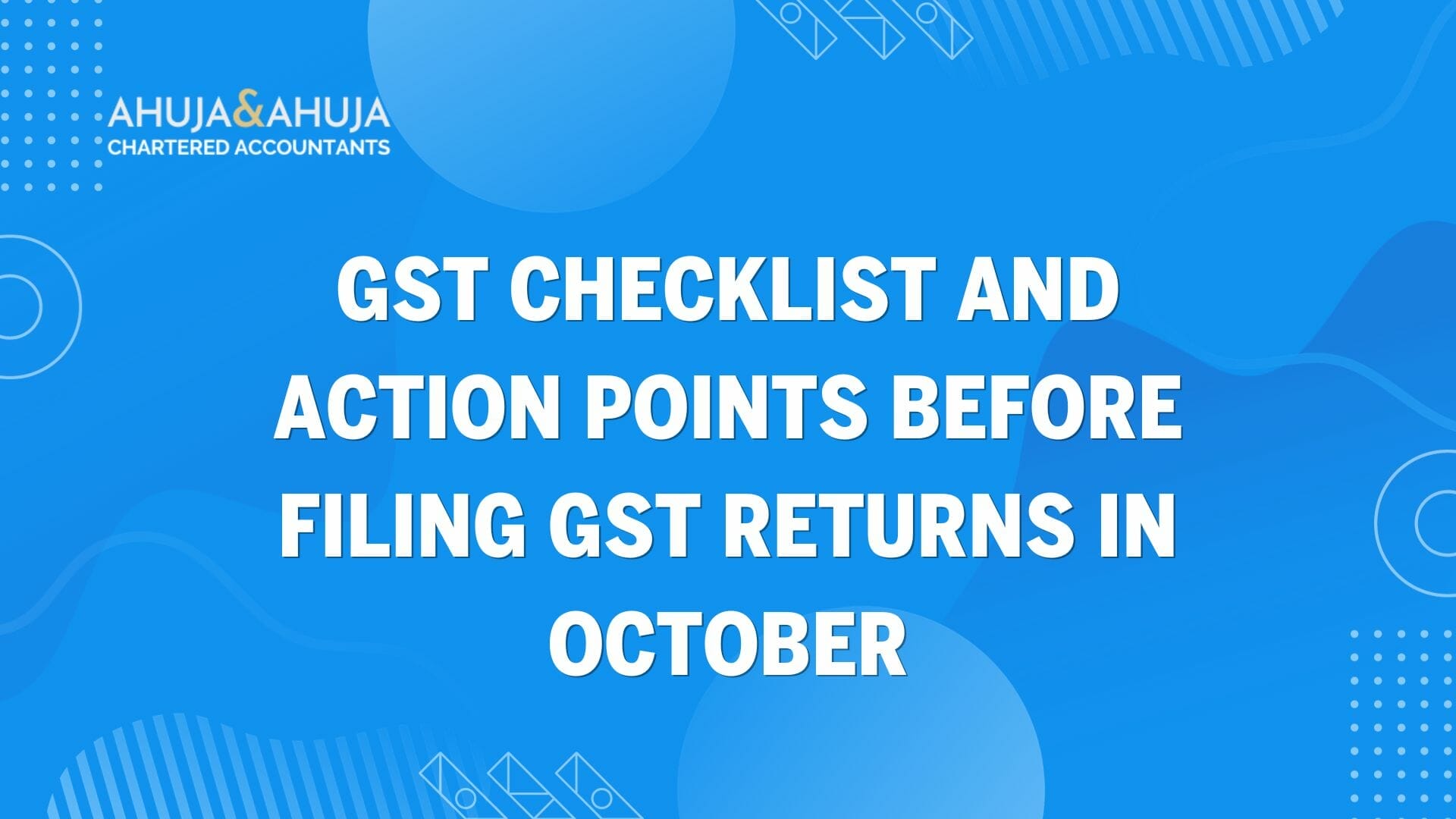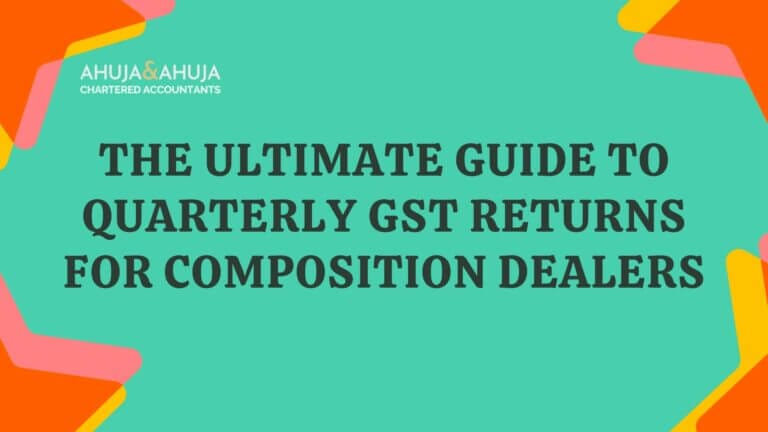GST Checklist and Action Points before filing GST Returns in October
The introduction of the Goods and Services Tax (GST) by the Government of India has transformed the entire taxation landscape. GST, a comprehensive indirect tax levied on manufacture, sale, and consumption of goods and services at a national level, replaces a series of indirect taxes like VAT, Service Tax, Excise Duty and so on. Transparency, seamlessness and efficiency in tax procedures have been hallmarks of GST, making it a significant step in the realm of indirect tax reforms in India(GST Registration Services India).
However, these admirable reforms have also introduced a new level of complexity for businesses in the form of GST filing. Regular filing of GST returns, and thereby acknowledging individual business transactions to the tax authorities, becomes a recurring duty for every business operating in India. Here’s where the efficiency of an experienced GST return filing service proves valuable.
October holds critical importance in this context, a time of the year that carries significant weight for every GST taxpayer in India. It is the last window to correct any inadvertent errors or genuine mistakes committed while filing the GST returns for the previous financial year. Mastering the act of filing correct GST returns within this limited timeline could save companies from potential penalties and offer an opportunity to optimize their finances.
This guide aims to walk you through crucial action points and offer a comprehensive GST checklist for filing returns in October 2023, interleaved with expert commentary and tax terminology simplified for the layman. Whether you’re a business owner, tax practitioner, or simply interested in the nitty-gritty of GST return filing, this guide is designed to be your companion through a potentially challenging process.
What is GST Return, and Why is it important?
A GST return is a document that contains details about the income and GST liability of a taxpayer for a specific period. It is important as it serves various purposes, including:
- Reporting sales, purchases, and tax liability to tax authorities
- Claiming input tax credit (ITC) on purchases
- Settling tax liabilities with the government
- Facilitating the reconciliation of data between taxpayers and tax authorities
Filing accurate GST returns is crucial for several reasons:
- Compliance with the Law: GST return filing is a legal requirement for all registered businesses under GST law. Failing to file returns can lead to penalties and legal consequences.
- Input Tax Credit: Timely and accurate filing allows businesses to claim input tax credit on their purchases, which helps in reducing their overall tax liability.
- Transparency and Accountability: GST returns promote transparency and accountability by ensuring that businesses report their transactions and pay the correct amount of tax.
- Avoiding Penalties: Filing returns on time and correctly is essential to avoid penalties imposed by the tax authorities for non-compliance.
Now that we have covered the importance of GST returns, we will delve into the specific checklist and action points to consider before filing GST returns in October 2023. In the following sections, we will discuss each point in detail, providing insights and suggestions for smooth and error-free filing. Stay tuned!
Understanding GST Checklist and Action Points
Now that we understand the significance of GST returns let’s explore the specific checklist and action points to consider before filing GST returns in October 2023. Paying attention to these crucial steps will ensure a smooth and error-free filing process.
A. Outward Supplies:
- Reconcile Outward Supplies: Begin by reconciling the outward supplies, including other income, as per your books of accounts with GSTR-1 and GSTR-3B. Identify any discrepancies and either account for them in your books or consider them in the GST returns.
- Reconcile Fixed Assets: Reconcile the details of fixed assets registered with the information disclosed in your GST returns. Make necessary adjustments in your books or GST returns to account for any differences.
- Verify E-Invoices: If your business is applicable for e-invoicing (such as B2B supplies, exports, and SEZ supplies), reconcile the invoices generated as per your books with the records on the e-invoice portal. Ensure that the Invoice Reference Number (IRN) is generated for all applicable supplies.
- Reconcile E-Way Bills: For the supplies of goods, reconcile the data of e-way bills with the information in your GST returns and books of accounts. This step is crucial as any movement of goods without a valid e-way bill, even if it remains unidentified during the movement, may attract penalties during departmental audit proceedings.
- Debit and Credit Notes: Reconcile the debit and credit notes as per your books with GSTR-1 and GSTR-3B. Adjust any differences accordingly.
- Export of Goods: For export of goods, reconcile the details mentioned on shipping bills with GSTR-1 to ensure accuracy in reporting.
- Supply of Services: Reconcile the advances received and adjusted as per your books of accounts with the declarations made in GSTR-1 and GSTR-3B. Ensure that the appropriate GST payment is made on such advance receipts.
- Verify Turnover: Reconcile the turnover from NIL rated, exempt, and non-GST supplies as recorded in your books with the respective disclosures made in your GST returns.
- Check HSN Codes: Verify whether the HSN codes accounted for in your books are reconciling with the HSN summary reported in GSTR-1 for this financial year. This step will be helpful when filing the GSTR-9 annual return as well.
- Rectification of Errors: October 2023 GSTR-1 is the final opportunity to rectify any error in reporting invoices, credit notes, or debit notes made while filing returns for the financial year 2022-23. If any tax credit notes are required to be issued, October 2023 is the last month to do so.
Ensure that you meticulously follow these steps to achieve accurate and compliant GST return filing. In the next section, we will move on to the action points related to inward supplies.
B. Inward Supplies:
- Reconcile Input Tax Credit (ITC): Reconcile the available and availed ITC as per your books of accounts with GSTR-2B and GSTR-3B. Ensure that the ITC claimed matches the information available in the returns. Communicate with vendors if any supplies are not reflecting in the GSTR-2B of your company.
- Payment Status to Suppliers: Check whether payments to suppliers for inward supplies have been made within 180 days. If any payments are pending, consider reversing the ITC along with interest and re-avail it in the month of payment to the supplier.
- Exempt Income and ITC Reversal: If your business has any exempt income, calculate and account for the reversal of ITC as per Rules 42 and 43 of the CGST Rules, 2017.
- Identify and Report Electronic Credit Reversal: Ensure that any ITC reversed during the financial year 2022-23 and pending for reclaim is identified and reported in the opening balance of the “Electronic credit reversal and reclaim statement.”
- Separately Record ITC for Inputs and Capital Goods: Identify and record ITC for inputs and capital goods separately in your books as per the requirement for GSTR-9 disclosure in Table 6.
By meticulously following these action points related to inward supplies, you can ensure accurate reporting and utilization of input tax credit. In the next section, we will focus on reconciling reverse charge mechanism (RCM) liabilities and other related considerations.
C. Reverse Charge Mechanism (RCM)
- Identify RCM Applicable Expenses: Review your books to identify all expenses on which the reverse charge mechanism applies. Examples include director sitting fees, legal expenses, security expenses, car hire charges, etc.
- Reconcile RCM Liability: Reconcile the expenses subject to reverse charge with the RCM liability discharged in GSTR-3B. Any differential liability should be discharged along with interest as per the applicable regulations.
- Foreign Expenditure Reconciliation: Reconcile the foreign expenditure as per your books of accounts with the imports of services disclosed in the GST returns and the corresponding RCM liability discharged.
- Self-Invoices for Unregistered Persons: Ensure that you have issued self-invoices for all supplies attracting RCM liability and received from unregistered persons.
By diligently following these action points related to the reverse charge mechanism, you can maintain compliance and avoid any potential issues during the GST return filing process. In the next section, we will discuss the reconciliation of GST payable/receivable balance and additional points for consideration.
D. GST Payable/Receivable Balance
- Reconcile GST Receivable or Payable: Reconcile the net GST receivable or payable as per your books of accounts with the closing balance reflected in your electronic credit ledger and cash ledger. This reconciliation should also consider any refund claims filed by your business.
- Consider Refund Claims: Ensure that any refund claims filed by your business are accurately reflected in the GST balance. Verify that the claimed refund amounts align with the corresponding entries in your books and returns.
By properly reconciling your GST payable/receivable balance, you can maintain accurate records and ensure compliance with tax regulations.
E. Additional Points for Consideration
- Cross-Charging Common Expenses: Identify common expenses incurred for related or distinct persons on which input tax credit (ITC) has been availed. Cross-charge these expenses to the respective entities based on the most rational and reasonable factors available. For example, you can allocate the expenses in the ratio of turnover of such entities.
- Correct Tax Discharge: Ensure that you have discharged tax liabilities under the correct heads as per the place of supply provisions. Pay attention to the specific rules and rates applicable to various supplies to avoid any discrepancies.
- Supplier Compliance Checks: Run a comprehensive check on all your suppliers to ensure their timely compliance with GST return deadlines. Promptly highlight any defaults or non-compliance to mitigate the risk of departmental action during audit proceedings.
By considering these additional points, you can further streamline your GST return filing process and maintain compliance with the tax authorities.
Common Questions about October GST Filing
- What happens if I miss the October deadline for filing GST returns?
Missing the October deadline for filing GST returns can attract penalties and consequences as per the GST provisions. It is essential to adhere to the deadlines to avoid any unnecessary complications.
- Can I still rectify errors in my GST returns after the October filing deadline?
Generally, the October filing deadline is the last opportunity to rectify any errors made in the GST returns for the previous financial year. It is crucial to double-check and rectify any mistakes before this deadline.
- Are there any consequences for filing incorrect GST returns in October?
Filing incorrect GST returns may lead to penalties and legal consequences. It is advisable to ensure the accuracy of the returns by following the GST checklist and action points provided in this article.
- What if I have missed reporting certain invoices in my previous GST returns?
If you have inadvertently missed reporting certain invoices in your previous GST returns, October provides the last chance to rectify such errors. Ensure that all invoices, credit notes, and debit notes are accurately reported in the appropriate returns.
- Can I revise my GST returns after filing in October?
Under normal circumstances, there is no provision for revising GST returns after filing them. Therefore, it is crucial to carefully review and ensure the accuracy of your returns before the October deadline.
By addressing these common questions, we hope to provide clarity and assist you in navigating the process of filing GST returns in October. Following the outlined checklist and action points will help you rectify any errors and ensure compliance with GST regulations.
Conclusion
In conclusion, the month of October is of paramount importance for every GST taxpayer in India. It serves as the final opportunity to rectify any inadvertent errors or genuine mistakes made while filing GST returns for the previous financial year. By diligently following the GST checklist and action points discussed in this comprehensive guide, businesses can ensure accurate and compliant GST return filing.
Remember, timely and accurate GST returns are essential to maintain compliance with the law, claim input tax credit, and avoid penalties. If you require any further assistance or expert guidance, consider reaching out to reputable GST services providers who can offer specialized support in GST return filing, GST refund services, and GST litigation services.
Stay vigilant, remain updated on GST regulations, and file your returns diligently to ensure smooth operations and financial efficiency in your business.
Disclaimer
The materials provided herein are solely for educational and informational purposes. No attorney/professional-client relationship is created when you access or use the site or the materials. The information presented on this site does not constitute legal or professional advice and should not be relied upon for such purposes or used as a substitute for professional or legal advice.







